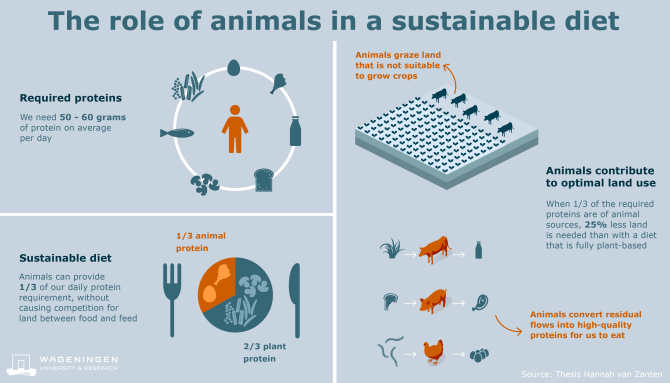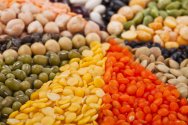
Dossier
Meat consumption
The relationship between meat consumption and a healthy and sustainable diet is a hot topic in social debate. Wageningen University & Research is studying the effect of eating meat on health, sustainability and climate. We also collect data on meat consumption, look at consumer behaviour and preferences, and investigate meat substitutes and alternative sources of protein. Our research can be used by public authorities, businesses and individuals to help them make informed decisions.
How much meat do the Dutch eat?
The average person in the Netherlands eats 76 kg of meat per year. This refers to consumption based on carcass weight, i.e. meat including bones, fat and skin. As a rule of thumb, roughly half of this is actually consumed as meat and meat products. There was a slight drop in meat consumption between 2010 and 2015. For 2018 the figures show a slight increase for the first time in 10 years. In pandemic year 2020 there is a decrease of 1.9 kg compared to 2019.
About half of Dutch people call themselves ‘flexitarians’. This means that they don’t eat meat with their main meal at least three times a week. The proportion of vegetarians is stable, at just under five percent of the Dutch population.
Meat and health
Meat contains valuable substances for the functioning of the human body - as a source of energy, for cell division and for building bones and muscles. Useful substances in meat include (among other things) proteins, vitamins B1, B6 and B12 and iron and zinc. Meat is an important source of protein in the diet for many people. The recommended amount for healthy adults is 0.83 grams of protein per kilogram of body weight. So someone weighing 70 kilos needs 58 grams of protein per day.
Extra protein is also important for pregnant women, breastfeeding women and for (endurance / strength) athletes. With some health conditions extra protein intake is also recommended.
Vegetable proteins
For vegetarians and vegans, the needed amount of proteins is respectively 20 and 30 percent higher. They (mostly) take vegetable proteins for this purpose. It is not yet known, whether vegetable protein is just as healthy as animal protein. Protein is an important building material for the muscles. Vegetable protein is made up of different amino acids than those in animal products. It’s being investigated what eating exclusively vegetable proteins means for muscle mass and muscle quality.
In the Netherlands, the average daily consumption of protein is 109 grams, of which about 40 percent is vegetable. On average we actually consume more protein than recommended. We are also investigating the health effects of this high intake. By reducing the intake of animal proteins, benefits for the environment can be achieved.
More about meat and health
What if you eat too much meat?
Eating too much red meat (such as pork and beef) entails health risks. Red and - in particular - processed meats such as meat fillings are associated with strokes, type 2 diabetes and colon cancer.
What if you eat little or no meat?
According to food scientists, healthy eating with less or no meat at all is possible if you know what other products you need. It is important to get enough and the right proteins and enough iron, vitamin B1 and vitamin B12.
Sustainable consumption
A modest amount of meat fits into a sustainable diet. Livestock can play a useful role in food production: we can feed animals biomass that humans can’t eat, such as leftover streams and grass that grows on soils that are not suitable for arable farming. This has, in fact, been the traditional role of farm animals: to convert leftover streams and biomass that is inedible to humans into high-quality protein sources such as dairy, eggs and meat.
More about the circular agrofood system
An essential element of a circular agrofood system is that we feed animals leftover streams and grow as little feed specifically for animals as possible, as is currently done on a huge scale.
The transition to a circular agrofood system in which animals are fed exclusively on by-products, leftover streams and grass represents a radical change that presents major challenges for aspects such as nutritional balance and food safety.
Preliminary calculations show that the most sustainable diet in a circular food system contains about 20 grams of animal protein per day.

Animal production and sustainability
Food production has an impact on the environment (soil, air and water) and our living environment. WUR is doing research on the effects of animal production (meat, dairy, eggs) on the environment and our surroundings. These include emissions of phosphate, ammonia and fine particulates.
More about climate-smart livestock farming
Livestock farming accounts for about seven percent of greenhouse gas emissions in the Netherlands. Cows and other ruminants are responsible for a significant part of this because they emit the greenhouse gas methane.
In the Netherlands, most cows are kept primarily for milk production. About three percent of all CO2 equivalents in the Netherlands are released as a result of fertilising agricultural and grazing land for cows.
Wageningen University & Research is doing research on how greenhouse gas emissions from livestock can be reduced. For example, we are looking into whether modifying the feed can reduce emissions and whether emissions from manure can be reduced by separating, cooling or mixing oxygen into the manure. Some cows naturally emit less methane, and this can be taken into account in breeding.
Protein transition
As the world population grows and prosperity increases, demand for meat and dairy products is expected to increase rapidly all over the world over the next few decades. At the moment, the supply of protein is unevenly distributed around the world. There is overconsumption in rich Western countries, especially of animal protein, and malnutrition elsewhere in the world. Protein transition involves the transition to a sustainable food system in which everyone can consume a sufficient amount of high-quality protein.
More about protein transition
A sea change is needed, in both the production and the consumption of protein.
If we are to produce sufficient protein without depleting the earth, we need a more diverse supply of protein for feed and food. Protein from plants (including seaweed and algae), microbes and invertebrates (including insects and shellfish) can contribute to a healthy diet that does not do excessive harm to the earth.
WUR is investigating which strategies are most effective at getting people to switch to a sustainable and healthy diet with different types of protein.
Meat substitutes and alternative protein sources
WUR is working on the development of various technologies for optimising the quality of meat alternatives. Shear-cell technology is a revolutionary method of creating meat-like structures which enables us to produce meat substitutes on a large scale. Over the long term, 3D food printing will allow us to create meat alternatives with a taste and texture that is tailored to personal preferences.
More about meat alternatives
Food safety
Meat is an animal product, and that incurs risks. Treating sick animals with antibiotics, for example, is permitted in the Netherlands after consultation with a vet. Residues of these antibiotics can accumulate in the meat, but in the Netherlands we have meticulous inspection programmes to monitor this. WUR is developing methods to make these inspections ever more efficient and effective.










